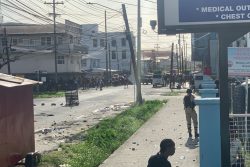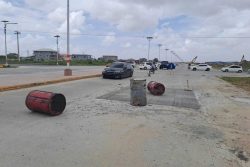The announcement by the Guyana Government on March 30th via the Department of Public Information (DPI) that 500,000 pounds of cassava had been delivered to the Deep South Rupununi underlines the food security threat that hinterland communities face.
When these Amerindian communities have to be supplied with the staple that they have depended on for time immemorial it must drive home clearly the climate-induced jeopardy which threatens their subsistence lifestyle and regional supply chains. It is not only the Deep South to be supplied. DPI reported that a further 500,000 pounds, valued at $20 million, will soon be distributed to Nappi and eight surrounding villages.
Neither the government nor the National Toshaos Council (NTC) has spoken in any detail about the food security threat facing Amer-indian communities. However, during their visit to the city for the NTC conference last September, some toshaos spoke to this newspaper about the dire challenges.
Toshao Charles Simon from Awarewaunau, Deep South Rupununi, Region 9 told Stabroek News that floods earlier in the year had destroyed most of the crops in his village. After the floods receded, farmers replanted the root crop but were experiencing the El Nino weather system, and the excessive dryness was hastening the deterioration of the crop. Mr Simon also attributed the cassava scarcity to foraging wild-life, a possible consequence of El Nino’s larger impact deeper in the rainforest. Mr Simon said then that the food security situation in his village was critical. Because of low cassava production, cassava bread and farine production had also been significantly scaled back.
Toshao Michael Williams of Annai, North Rupununi, Region Nine told Stabroek News that after the floods, cassava crops were replanted but these would not be available for another three months. Mr Williams said that the shortage of cassava had also sent the prices in Annai for farine, cassava bread and casareep skyrocketing.
No information has been provided on which part of the country one million pounds of cassava has been sourced from, the cost attached or the logistics involved but it is the type of occurrence which had impelled regional governments to move towards a food terminal to enable precisely the operation mounted by the Guyana Government to relieve the plight faced by Rupununi communities. However, the information blackout on progress in that project continues.
Insofar as the Caribbean Community (CARICOM) is concerned the issue of regional food security has either been ‘parked’ in the face of other regional issues that have surfaced over the past year (the seemingly worsening impact of climate might, conceivably be one of those) or else, it has become reduced to a more sedate pace, as is often the case with matters that are of importance to the region.
Caribbean Governments are known for having ‘tilts’ at lofty, envisaged region-changing ambitions, the most recent of which has been the goal of enhancing the region’s food security bona fides, at a time when food scarcity is, for reasons of war and weather, among other considerations, pretty much at the apex of the global agenda of human concerns.
One can think of no profound and enduring decisions on regional food security that had been realized over the years, never mind the fact that it continues to be the case that the region, for the most part, is vulnerable to varying degrees of food scarcity. There may have been a few mostly ceremonial occasions that sought to signal an intention. It transpired that in the instance of the so-called Jagdeo Initiative, promulgated almost two decades ago, as “the basis of the vision that seeks to reduce the region’s food import bill by 25 per cent by 2025,” the project simply melted into rancour and discord never mind the fact that there still appears to be a measure of hope being held out for the success of the 25×2025 initiative designed to reduce the region’s food import bill.
In the meantime, the region’s most recent food security initiative, spearheaded by President Irfaan Ali and Prime Minister Mia Mottley would appear to have stalled, or at least slowed down considerably, in the wake of what has been the failure, up to this time of anything that comes even close to resembling a reassuring update on the pace of progress towards the completion of the Terminal. Nor has there been, up to this time, any response to the failure to provide the people of the region with a reassuring update by either the two lead regional Heads of Government (or their ‘Food Security’ Ministers on the issue.
These circumstances, it has to be said, are far from reassuring signs at a time when the extent of the Caribbean’s food security shortcomings vary from one country to another and where we are acutely aware of the particular plight of many of the smaller territories in the region, hamstrung as they are by overwhelming dependence on extra regional food imports.
There are other regional challenges that have become attached to the issue of food security. One of those, and a particularly worrisome one, being climate change and its implications for the all-round well-being of the region that extends beyond food security.
We live in a region where there exists a patent lack of capacity to effectively address several pressing issues simultaneously and here one suspects that the issue of regional food security, its particular importance notwithstanding, has to take its place in a queue that includes no less weighty matters, like climate change. In the case of the Rupununi cassava supply climate change and food security have become entwined.
As things stand and for all of the hype that has attended the evolution of the latest phase of the Caribbean Food Security Initiative – a fitting title here might be The Ali Mottley Food Security Mission – which, for a while at least, thrived on its acceptance as a noble motive – but which, may now be in danger of performing a ‘belly flop’ in the absence of any publicly known update on the pace of progress towards its completion up to this time.
The protracted period of silence on the extent to which the Food Security Terminal has progressed affords more than sufficient reason for concern that there may still be nothing, or, more generously, little to report on the pace of progress towards the creation of the Terminal. If this is so the regional leaders charged with overseeing the execution of the project must say so now and in the process, provide us with a definitive update as just where the region stands in terms of its food security ambitions. There is no greater regional emergency at this time.








